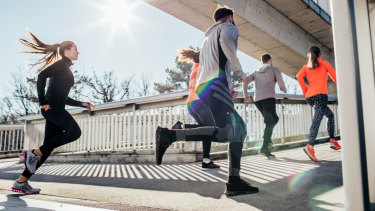Winter is upon us. And with temperatures plummeting, the idea of heading outdoors to exercise is less enticing. After all, it’s far more tempting to curl up on the couch with a good book than brave the elements.
But getting active in the cold has its benefits says exercise physiologist Andrew Daubney from Rebound Health. First, he says, regular activity can help you fight off winter lurgies by improving your immune system.
The social aspect of exercising can be the strongest motivator.Credit:Stocksy
Plus, he says, it can actually be easier to exercise in nippy weather, as your body can regulate its temperature more effectively. You may even be able to go for longer, as you don’t have to work as hard to cool down.
But while exercising outdoors in winter may be good for you, this doesn’t make it appealing. Which is why you need to work on your attitude, says personal trainer Kylie Anderson from Be Your Radiant Self. She suggests honing in on the beauty of nature at this time of year, the benefits of being active, and the ways you can make the experience more palatable.
The first step is to dress appropriately, says Tim Oberg, the Australian founder of Parkrun, a free event that sees 50,000 people around the country partaking in a five-kilometre walk or run each Saturday morning. While his advice may seem obvious, he says having the right gear can really affect your experience.
“If in doubt about how many layers you’ll need, it’s always best to have one more than you think,” he says.
He recommends waterproofing your shoes, donning gloves, beanies and tights, and wearing a waterproof jacket if it’s wet.
It also helps to pick your clothes wisely. Daubney explains that water is an efficient heat conductor, “so if you’re getting wet, you will feel cold very quickly”. He recommends opting for clothes made from synthetic fibres – which are designed to dry quickly – rather than cotton.
While warming up is important, Daubney says it’s even more vital in cold conditions. “Warm-ups should be dynamic, rather than static stretching, and should increase blood flow to the muscles to reduce the risk of injury.”
When you’re ready to face the cold, says Anderson, try to do so with a friend. Alternatively, she suggests joining a group activity, such as a boot camp, an event like Parkrun, or a training class. Oberg says you can’t downplay the social aspect of exercising, as it can be one of the “strongest motivators” for getting going.
Once you’re outside exercising, make sure you stay hydrated. You might not feel as thirsty in the cold, but Daubney says you’re still losing fluids through sweat. And it’s important you don’t forget your sunscreen, either.
When your alarm goes off and it’s dreary outside, chances are you’ll be tempted to toss your good intentions out the window. That’s when you need to remember your internal motivation, says Oberg. This is the reason why you wanted to be active in the first place. It might be to lose weight, for mental health, or to try to beat a personal best. So don’t let a little drizzle stop you from reaching your goals.
You need to build in other incentives, too. For example, Daubney suggests planning to finish your workout near your favourite cafe so you can enjoy a hot drink afterwards.
Finally, think about how good you’ll feel when you’re done. Oberg says that, physically, you’ll feel “invigorated”, while psychologically, you’ll have the satisfaction of not allowing the weather to derail your plans.
So, the next time you’re hesitating about working out when it’s chilly, take a leaf out of Oberg’s book. “In my opinion, it’s the best time of year to train,” he says. “You might be cold for the first couple of minutes but once you get moving, it’s just beautiful.”
This article appears in Sunday Life magazine within the Sun-Herald and the Sunday Age on sale August 4.
Source: Read Full Article

